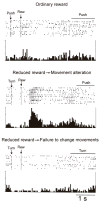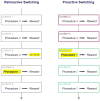Switching from automatic to controlled behavior: cortico-basal ganglia mechanisms
- PMID: 20181509
- PMCID: PMC2847883
- DOI: 10.1016/j.tics.2010.01.006
Switching from automatic to controlled behavior: cortico-basal ganglia mechanisms
Abstract
Most daily tasks are performed almost automatically, but occasionally it is necessary to alter a routine if something changes in the environment and the routine behavior becomes inappropriate. Such behavioral switching can occur either retroactively based on error feedback or proactively by detecting a contextual cue. Recent imaging and electrophysiological data in humans and monkeys support the view that the frontal cortical areas play executive roles in behavioral switching. The anterior cingulate cortex acts retroactively and the pre-supplementary motor area acts proactively to enable behavioral switching. The lateral prefrontal cortex reconfigures cognitive processes constituting the switched behavior. The subthalamic nucleus and the striatum in the basal ganglia mediate these cortical signals to achieve behavioral switching. We discuss how breaking a routine to allow more adaptive behavior requires a fine-tuned recruitment of the frontal cortical-basal ganglia neural network.
Figures




Comment in
-
Proactive and reactive recruitment of cognitive control: Comment on Hikosaka and Isoda.Trends Cogn Sci. 2010 May;14(5):191-2. doi: 10.1016/j.tics.2010.02.006. Epub 2010 Apr 1. Trends Cogn Sci. 2010. PMID: 20363177 No abstract available.
Similar articles
-
Frontal-subcortical circuits: the anatomic basis of executive, social and motivated behaviors.J Psychopharmacol. 1997;11(2):107-14. doi: 10.1177/026988119701100203. J Psychopharmacol. 1997. PMID: 9208374 Review.
-
Cognitive potentials in the basal ganglia-frontocortical circuits. An intracerebral recording study.Exp Brain Res. 2004 Oct;158(3):289-301. doi: 10.1007/s00221-004-1901-6. Epub 2004 Jun 22. Exp Brain Res. 2004. PMID: 15221170
-
Evidence for a direct subthalamo-cortical loop circuit in the rat.Eur J Neurosci. 2008 May;27(10):2599-610. doi: 10.1111/j.1460-9568.2008.06229.x. Eur J Neurosci. 2008. PMID: 18547246
-
Organization of inputs from cingulate motor areas to basal ganglia in macaque monkey.Eur J Neurosci. 2001 Nov;14(10):1633-50. doi: 10.1046/j.0953-816x.2001.01789.x. Eur J Neurosci. 2001. PMID: 11860458
-
Neural circuits and functional organization of the striatum.J Neurol. 2000 Sep;247 Suppl 5:V1-15. doi: 10.1007/pl00007778. J Neurol. 2000. PMID: 11081799 Review.
Cited by
-
Neural and behavioral mechanisms of proactive and reactive inhibition.Learn Mem. 2016 Sep 15;23(10):504-14. doi: 10.1101/lm.040501.115. Print 2016 Oct. Learn Mem. 2016. PMID: 27634142 Free PMC article. Review.
-
Behavioral and neurophysiological evidence for increased cognitive flexibility in late childhood.Sci Rep. 2016 Jun 28;6:28954. doi: 10.1038/srep28954. Sci Rep. 2016. PMID: 27349808 Free PMC article.
-
Metacognitive and Non-Metacognitive Processes in Arithmetic Performance: Can There Be More than One Meta-Level?J Intell. 2022 Aug 4;10(3):53. doi: 10.3390/jintelligence10030053. J Intell. 2022. PMID: 35997409 Free PMC article.
-
Stimulus specificity in combined action observation and motor imagery of typing.Q J Exp Psychol (Hove). 2025 Mar;78(3):575-593. doi: 10.1177/17470218241241502. Epub 2024 Apr 10. Q J Exp Psychol (Hove). 2025. PMID: 38482583 Free PMC article.
-
A Functional Magnetic Resonance Imaging Investigation of Hot and Cool Executive Functions in Reward and Competition.Sensors (Basel). 2025 Jan 29;25(3):806. doi: 10.3390/s25030806. Sensors (Basel). 2025. PMID: 39943445 Free PMC article.
References
-
- Monsell S. Task switching. Trends Cogn Sci. 2003;7:134–140. - PubMed
-
- Holroyd CB, Coles MG. The neural basis of human error processing: reinforcement learning, dopamine, and the error-related negativity. Psychol Rev. 2002;109:679–709. - PubMed
-
- Rushworth MF, et al. Action sets and decisions in the medial frontal cortex. Trends Cogn Sci. 2004;8:410–417. - PubMed
-
- Botvinick MM, et al. Conflict monitoring and anterior cingulate cortex: an update. Trends Cogn Sci. 2004;8:539–546. - PubMed
-
- Sakai K. Task set and prefrontal cortex. Annu Rev Neurosci. 2008;31:219–245. - PubMed
Publication types
MeSH terms
Grants and funding
LinkOut - more resources
Full Text Sources

